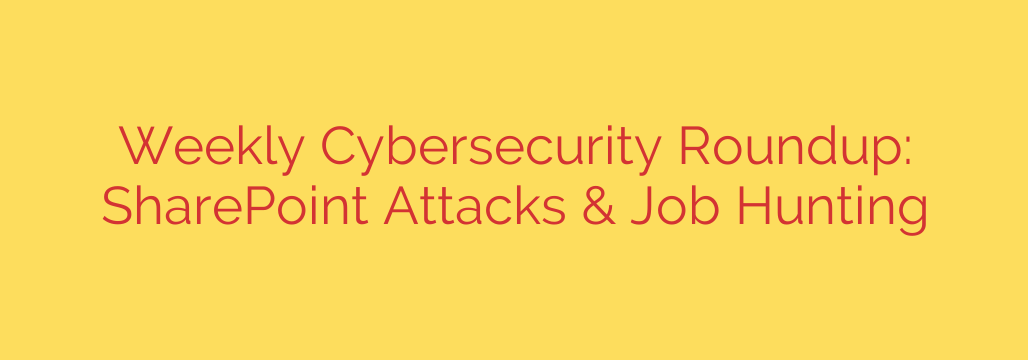
Stay Alert: Hackers Target SharePoint and Job Hunters with Sophisticated Scams
In today’s digital world, cybercriminals are constantly finding new ways to exploit trusted platforms and human behavior. Two significant threats have recently emerged, targeting both businesses through Microsoft SharePoint and individuals searching for new career opportunities. Understanding these evolving tactics is the first step toward protecting yourself and your organization from potentially devastating attacks.
SharePoint Exploited: A Trusted Tool Turned into a Weapon
Microsoft SharePoint is a powerful collaboration tool used by millions of businesses worldwide. Its trusted reputation is precisely what makes it a new, dangerous target for hackers. A recent wave of attacks shows that cybercriminals are abusing Microsoft SharePoint’s file-sharing features to deliver malware and bypass security protocols.
The attack is deceptive in its simplicity. It often begins with a carefully crafted phishing email that appears to be a legitimate file-sharing notification from SharePoint. Because the link in the email points to a genuine SharePoint domain (sharepoint.com), it successfully bypasses standard email security filters that would typically flag suspicious URLs.
Once a user clicks the link, they are taken to a real SharePoint page hosting a malicious file, often disguised as a document or a ZIP archive. The user, believing they are on a secure Microsoft platform, is more likely to download and open the file. This action lures victims into downloading malware, ransomware, or spyware directly onto their system, giving attackers a foothold within the corporate network.
How to Secure Your SharePoint Environment
Protecting your organization requires a multi-layered defense strategy.
- Enhance Employee Training: Educate your team to be suspicious of all unsolicited file-sharing links, even those from trusted services. Teach them to verify the sender’s identity through a separate communication channel before clicking.
- Implement Multi-Factor Authentication (MFA): Enforcing MFA on all Microsoft 365 accounts is one of the most effective ways to prevent unauthorized access, even if credentials are stolen.
- Configure Sharing Policies: Review and tighten your SharePoint sharing settings. Limit anonymous or public sharing and restrict access for external users to only what is absolutely necessary.
- Utilize Advanced Threat Protection: Deploy security solutions that can scan files within SharePoint and OneDrive for malicious content in real time.
Navigating the Dangers: Scammers Target Eager Job Seekers
The competitive job market has created a fertile ground for another type of cybercrime. Scammers are now actively targeting job hunters, exploiting their eagerness and trust to steal sensitive information and money. These criminals are posing as recruiters from legitimate companies, using sophisticated social engineering tactics to appear credible.
The scams often begin on professional networking sites like LinkedIn or through fake job postings on popular job boards. These listings look authentic, often copying details from real positions. When an applicant responds, the “recruiter” may conduct a fake interview via text or chat apps and quickly extend a fraudulent job offer.
This is where the real danger begins. Scammers use the excitement of a new job offer to pressure victims into providing sensitive data. Their goals include:
- Identity Theft: The criminals will ask for a Social Security Number, driver’s license, and bank account details under the guise of setting up payroll or conducting a background check.
- Financial Fraud: In some cases, job seekers are asked to pay for their own work equipment or training materials, with a promise of reimbursement. The scammers take the money and disappear.
- Credential Harvesting: The application process may lead to a fake portal designed to mimic a real company’s career page, tricking applicants into entering login credentials that can be used elsewhere.
Tips for a Safe and Secure Job Search
A dream job offer should be a cause for celebration, not concern. Follow these tips to protect yourself.
- Verify Independently: Before providing any personal information, independently verify the job opening by visiting the company’s official career page. Do not rely on the links provided in an email.
- Scrutinize Email Addresses: Legitimate recruiters will almost always contact you from a corporate email address (e.g., [email protected]), not a generic one like @gmail.com or @outlook.com.
- Guard Your Personal Data: Do not provide your Social Security Number or bank details until you have received and signed a formal, verifiable offer letter and completed official onboarding paperwork.
- Red Flag: Paying for a Job: A legitimate employer will never ask you to pay for equipment or a background check as a condition of employment. This is a major red flag.
- Trust Your Instincts: If an offer seems too good to be true, the interview process is rushed, or the recruiter’s communication feels unprofessional, it’s best to proceed with extreme caution.
Vigilance is Your Best Defense
The line between our professional and personal digital lives is increasingly blurred, and cybercriminals are exploiting every opportunity this creates. Whether it’s a malicious file hiding in a trusted cloud service or a fake recruiter preying on ambition, the core threat remains the same: exploiting human trust.
By staying informed about the latest tactics and adopting a security-first mindset in all your digital interactions, you can significantly reduce your risk and protect your valuable data.
Source: https://www.helpnetsecurity.com/2025/07/27/week-in-review-microsoft-sharepoint-servers-under-attack-landing-your-first-cybersecurity-job/








